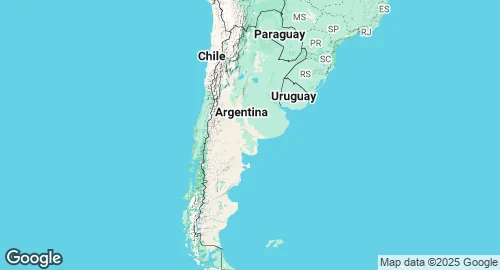Argentina Military Forces 🇦🇷
Military Strength Overview
| 🛩️ Air Force | 238 active aircraft |
| ⚓️ Naval forces |
46 ships in fleet
– incl. 2 submarines |
| 🪖 Active Troops | 72,100 personnels |
| 👮♀️ Paramilitary | 31,250 personnels |
Defense Statistics & Key Metrics
| Population | 45.5 million (2023) |
| GDP | $646.1 billion (2023) |
| GDP per capita | $14187 (2023) |
| Military Budget | $4.2 billion (2024) |
| Share of GDP in Milex | 0.6% (2024) |
| Share of Govt Expenditures | 1.9% (2024) |
| Military spends per capita | $92 (2024) |
| Military Personnel | 103,000 (2020) |
Strategic Overview in 2025
Argentina's military is defined by decades of underfunding, systemic economic crises, and the political legacy of the 1976-1983 dictatorship. While it faces no immediate threat of conventional warfare, its strategic challenges are significant and varied, ranging from transnational organized crime and illicit fishing to the unresolved sovereignty dispute over the Falkland/Malvinas Islands. The armed forces' capacity to effectively address these issues is hampered by severe budgetary constraints and aging equipment, creating a substantial gap between its strategic responsibilities and its capabilities.
Military Forces and Capabilities
The Armed Forces of the Argentine Republic consist of the Army, Navy, and Air Force, with the National Gendarmerie and Naval Prefecture serving as security forces that can be mobilized in a conflict. The President is the Commander-in-Chief, with a civilian Minister of Defense overseeing the military establishment.
Years of economic turmoil have severely eroded military readiness. The 2024 defense budget is one of the lowest in South America relative to GDP. This has resulted in a chronic lack of modernization, inadequate training, and maintenance failures, tragically highlighted by the loss of the submarine ARA San Juan in 2017.
The Argentine Army is structured around a series of armored, mechanized, mountain, and jungle brigades. However, much of its equipment, including its fleet of M113 armored personnel carriers, is outdated. The Argentine Navy struggles with a small and aging surface fleet and a nearly non-existent submarine capability. The Argentine Air Force decommissioned its last supersonic interceptors in 2015 and has since lacked a primary combat aircraft, a critical capability gap.
The domestic defense industry, with firms like FAdeA, has potential but is stymied by the lack of consistent government investment.
Strategic Trends and Modernization
The current administration under President Javier Milei has signaled a significant foreign policy recalibration, moving closer to the United States and the West while distancing from China and Russia. This shift is reflected in recent procurement decisions. A key development is the planned acquisition of 24 second-hand F-16 fighter jets from Denmark, a move that will restore the Air Force's supersonic intercept capability.
Further modernization plans are ambitious but contingent on securing external financing, a significant hurdle given the nation's economic state. These plans include the potential acquisition of new submarines (possibly French Scorpene-class), wheeled armored vehicles for the Army (such as the Stryker), and P-3 Orion maritime patrol aircraft to better monitor its vast Exclusive Economic Zone against illegal fishing.
Argentina's primary security concerns are asymmetric. It serves as a transit zone for narcotics, fueling crime and violence in cities like Rosario. Patrolling its maritime resources against large-scale illegal, unreported, and unregulated (IUU) fishing, predominantly by Chinese fleets, is another major challenge that the current forces can barely meet. While the Falklands/Malvinas dispute remains a constitutional issue and a point of national pride, it is being pursued through diplomatic rather than military means.
Argentine Military Budget History
Population and Military Personnel Trends
GDP and Inflation Rate Trends
Argentine Aircraft Manufacturing
| Model | Manufacturer | Year | Number |
|---|---|---|---|
| IA 58 Pucará | FMA | 1974 | 110 |
| IA-63 Pampa | FMA | 1984 | 32 |
Military Expenditure: SIPRI Milex.
